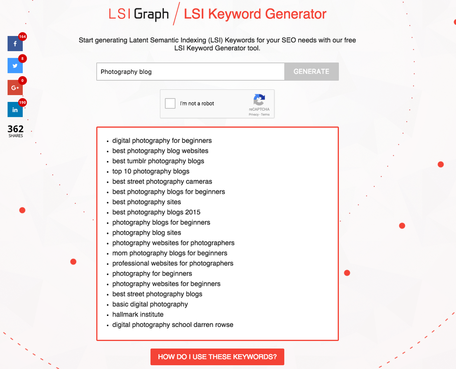What are blogs used for?In today’s digital world, a well-run, concise blog can be the difference in how and where your photography business is viewed. At the end of the day it’s all about revenue, every business wants more and more. Well how do you get it? You need more customers right? Well a functional blog could soon have you appearing higher than ever in google searches. Think of this simple idea: Higher Google page ranking => higher visibility => more customers => more revenue Simple right? Well here’s the kicker – it takes time and hard work. There’s no point in churning out content if it’s not,
In this post I’ll go through the whole process of writing a successful blog post. From setting it up, picking your topic, creating a coherent brief and the actual writing process. We’ll leave no stone unturned, so by the end of the post (only 12 minutes!) you’ll be raring to go and start blogging. Choosing a blogging platformThere are a number of places where you can set up your new photo blog. The most popular of these is WordPress.com. Entirely free and simple to use, wordpress.com is the go to for anyone looking to start a blog. Although, it does have its drawbacks. You essentially don’t own the published content on the blog, you really are at the mercy of WordPress or whoever you decide to use. Your blog could be shut down at any time and for any reason. Your domain will also most likely have to incorporate the site name, making it unnecessarily long and unattractive. If you’re serious about blogging you really should consider using a paid service. Alongside WordPress.org, sites like Weebly and SquareSpace offer some great, easy to use templates. These services operate on a small monthly fee and given their simple design and wealth of available plugins, they really are a worthwhile investment. So once you’ve chosen where to host your blog, you can get right down to picking the perfect domain name for your new photography blog. My advice would be to keep it simple. Choose a name that’s easy to read and doesn’t spell anything unusual once written down! You want your name to be easily understood by readers and by google so don’t use any hyphens, numbers or odd characters. Whether you want to use your company’s or your own name is entirely up to you. Just make it in your own style and you can’t go wrong. Now on to the good stuff, what to write about? Topics for my photography blog?So, this first step actually trumps quite a lot of people. Just what the hell do I write about? Well lucky for you there’s a lot of places you can source information from. First of all, what’s your business? Are you a wedding photographer? If you are, great, write about that. If not, don’t! If you primarily shoot weddings it’s unlikely you’ll be seen as the authority on newborn photography. Stick to what you know and you’re passionate about. Next, have a look around the industry, check out your competitors’ blog, what are they writing about? See something they’ve done but think you can do it better? Perfect, do it! The power of search! Think about how people search for information nowadays. They use google right? So go straight to the source! Simply start typing in google and see what the suggestions are. This is an invaluable tool, you’re seeing what questions real customers are asking, go ahead and answer them. There are also loads of online tools out there to help you. Like Answerthepublic.com. This is a great resource for sourcing blog ideas. Enter any phrase at all in the search bar and AnswerThePublic will throw up a list of questions for you to consider. Questions are split into who, why, what, where, when and also into prepositions like can, with, without etc. There’s bound to be something that grabs your attention. And last but certainly not least, remember that this is a photography blog. So blog about yourself, the photographer! Write about your photos, your shoots, your edits, your entire process. Pick a day and bring us behind a shoot. Got a favourite location to shoot a wedding? Great, tell us about it. You may not be an expert (yet!) but you’ve got to have an interest and a passion in your subject. This is a creative industry, get creative! Actually writing!Once you’ve picked a topic for you blog post it’s time to get down the real nitty gritty, the actual writing. Here there really is a sense of each to their own style. Personally I like to create a brief, make a clear plan of all my keywords to be included and organise each section by length and paragraph breakdown – yeah I’m a nerd! I would caution against just charging ahead blindly and churning out words. You do need some semblance of a brief. For a brief, let’s look at keywords first. Let’s say your topic is based around wedding photography. Head over to the Google Keyword Planner Tool and plug in “wedding photography”. The results of this search will form the bulk of keywords you’ll use throughout the post. When choosing your keywords pay attention to the tabs in the planner. Namely Competition and Search Volume. While it’s important to include the necessary keywords, if you’re a new and small business it’s unlikely that you’ll be able to compete for the keywords marked as high competition. Which brings me on to my next suggested tool – LSI Graph. Skip past the jargon of what LSI stands for (Latent Semantic Indexing) and look at this simple explanation: LSI finds long tail keywords. Basically, it works to find synonyms of your primary keyword that you have entered. LSI keywords allow you to avoid keyword stuffing (a big Google no-no!). Long tail keywords help Google to differentiate your content from that of others. It’s good practice to include one primary keyword with a long tail keyword in each paragraph. But it’s important not to force it. Write naturally, if it doesn’t fit, don’t put it in. A great way to consider it is this: You shouldn’t have to make it sound natural, it should just be natural. Now, how to organise your content – cast your mind back to those dreaded school essays. You were always told to have a beginning, a middle and an end. It’s no different here. Your post has to be structured in a way that makes it easy to read. So start with a simple and catchy headline followed by an informative intro which leads smoothly into your main body of points. Lastly, finish off with a brief conclusion to tie it all off. And don’t forget that great content isn’t just the written word! So get your most recent shoot photos up there. Images and videos are the perfect way to keep a waning reader interested! LayoutFor the layout I like to keep to the proven formatting of plenty of useful headings and subheadings and to organise your thoughts and paragraphs clearly with plenty of white space. The majority of people will only scan your post, you need to make it easy to read. If your post is just one block of text you can be sure most people will simply move on. Using headings, subheadings and bullet points not only makes your text easier to read, it also helps Google’s bots to easily decipher the content’s purpose. How often should I post and how long should it be?These questions can be difficult to answer. It really comes down to what your goals are. Think about the size of your marketing team. In all likelihood your photography business is just you, so stick to what’s manageable. Don’t let the quality suffer. If you can post everyday then great, if you can only manage weekly posts then that’s fine too. Just strive for relevant and useful content. The suggested length for blog posts is anywhere from 500–4000 words. Photography blogs should aim for around 1500 words. But, play around with it. Try different lengths, at different times on different days and see what works for you. One final reminder (almost done I promise!)Don’t forget to sell yourself. Starting a new blog is the perfect way to promote your photography business, so don’t forget to include a plug at the end. This can be a simple link to your packages or a question designed to hook in the reader. Either way, don’t hesitate to promote yourself, if they’ve made it to the end you can make the logical assumption that they’re interested in photography. So there we have it, a quick guide to starting your new photography blog. Good luck with it!If you plan on starting a new blog or picking up an old one, be sure to let us know how you get on! If you’ve got any questions, get onto us in the comments and we’ll do all we can to help you out! Keep an eye out for our next post in this online marketing tips series – Boost your photography business with Google Analytics. While we have you, we'd love you to check out our new E-book – How to Increase your Sales, available here.
If you're a professional photographer you've got to check this out!
2 Comments
Leave a Reply. |
AuthorsRonan Ryle Archives
August 2023
Categories
All
|
Information |
Products |
|








 RSS Feed
RSS Feed